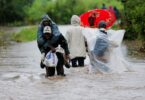Sharon Udasin
Meteorologists are anticipating strong El Niño conditions this winter, with widespread wetness likely to drench much of the California coast as soon as next month and persisting into spring.
“Currently, we have El Niño conditions, strong El Niño conditions at that. And those are continuing to intensify,” Daniel Swain, a climate scientist at the University of California, Los Angeles said during a recent webinar on the subject.
“Models suggest that the current El Niño event will further strengthen it potentially into a very strong, or a quote-unquote, ‘super’ El Niño event, within the next couple of months,” he added.
El Niño is one of two phases in the El Niño–Southern Oscillation phenomenon — the stage in which trade winds weaken and warm Pacific Ocean water moves toward the Americas, according to the National Oceanic and Atmospheric Administration (NOAA).
In the northern U.S. and Canada, El Niño tends to come with drier and warmer conditions, while the South experiences increased flooding, per NOAA.
This year, El Niño has already grown “quite strong in the eastern tropical Pacific and is likely to become stronger still before it peaks later this year — probably sometime this winter,” Swain said.
A recent advisory issued by NOAA’s Climate Prediction Center corroborated this assessment, reporting a 62 percent chance that El Niño would continue in the Northern Hemisphere from April through June.
The advisory estimated that there is a greater than 55 percent chance of at least a “strong El Niño” extending from January through March, as well as a 35 percent chance of “historically strong” conditions from November through January.
While the system may not end up being “the strongest El Niño on record,” there is a strong possibility that it will land a top-10 ranking, Swain said.
Yet although most seasonal models indicate “a wetter-than-average winter in California,” European forecasts suggest a much weaker likelihood of such conditions, he noted.
“That gives us a little bit of pause, but we have to remember too, that no model is perfect,” Swain said. “If I had to put money on it, I’d put my money on wet, although I wouldn’t put a lot of money on it.”
But with a decent chance of precipitation in the cards, the Golden State’s Office of Emergency Services has begun warning Southern Californians to prepare for potential winter weather.
The state is hardly heading into the season with a moisture deficit. As of early November, California was entirely drought-free, according to the U.S. Drought Monitor, a database run by NOAA and the National Integrated Drought Information System.
Just six of the state’s 58 counties — Del Norte, Siskiyou, Modoc, San Bernardino, Riverside and Imperial in the south — received an “abnormally dry” classification, a step below drought.
A recent analysis from NASA, meanwhile, concluded that if a strong El Niño ends up developing this winter, western coastal cities of the Americas could endure increased high-tide flooding.
Such floods, per the analysis, could “swamp roads and spill into low-lying buildings.”
A fierce El Niño could cause up to five instances of what’s known as “10-year flood events” in many of these cities, including Seattle and San Diego, according to NASA.
While these types of floods don’t typically occur outside El Niño years, the NASA analysts stressed that rising seas and climate change could cause annual such events by the 2030s. And in El Niño years during that decade, the same West Coast cities could see up to 10 such 10-year flood events in just one year, the analysis found.
Although massive rains and flooding are certainly possible this year, Swain emphasized that a strong El Niño does not necessarily “offer a one-to-one correlation with wintertime precipitation.”
“In fact, it’s a very tortured and complicated relationship,” he said.
El Niño does come with huge amounts of moisture, but “the big wild card” is whether strong, upward vertical movements accompany the “weird blobs of warm water” in the atmosphere, Swain explained.
“Moisture in the atmosphere is not enough to produce rain — you need precipitation-generating mechanisms,” he said.
But Swain stressed that the development of any intense storms and floods would be attributable not just to El Niño, but also to climate change-induced warming.
If California does end up inundated by floods this winter, water expert Jay Lund told The Hill that the state would be “pretty well-prepared.”
Although last year’s wintry weather took a devastating toll on select small towns and neighborhoods, there was “nothing catastrophic for a large town or city,” according to Lund, director of the Center for Watershed Sciences at the University of California, Davis.
Nonetheless, Lund acknowledged that the Golden State’s reservoirs have remained quite full since last winter.
“For the bigger storms on the main rivers, they have less flexibility than they did last year this time,” he said.
The long-term solution to this quandary, in Lund’s opinion, is to move people out of the floodplain areas, rather than spending billions of dollars to build up flood control infrastructure.
“There’s just some amount of floods that it’s better to just tolerate the losses,” he said. “You don’t build a fireproof house — you buy fire insurance, because it’s a lot cheaper.”
But Lund reiterated that California “should be pretty well set” for this winter, while recognizing that “there’s always a chance that you’ll see a flood bigger than what you’re prepared for.”
While he credited California for performing better than most states with regards to evacuation plans, Lund also stressed that residents should not become complacent.
Right now, he explained, there are about 6,000 miles of levees in California, but just a small portion of one needs to fail “before a bunch of people get wet.”
“The nature of our water problems in California, including flood problems, is always changing,” Lund said.
“We’ll just have to adapt, and it’ll expensive; it’ll be inconvenient. But if we manage it well, it won’t be catastrophic,” he added.
Courtesy: thehill







